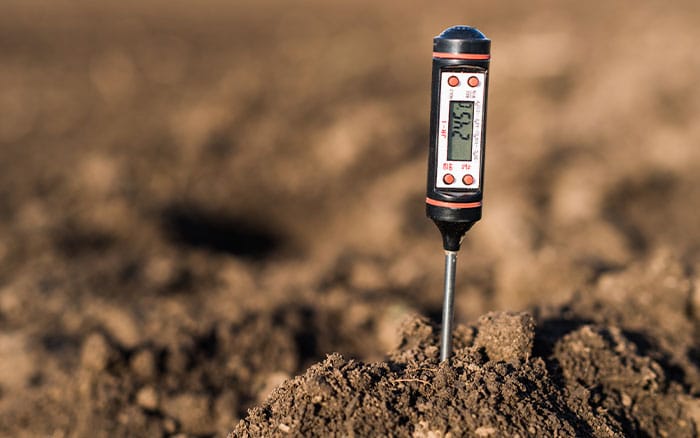If you sowed loads of veg seeds last month and now have a lot of seedlings, hold off on planting. Don’t be tempted to plant them outside until you’ve first warmed the soil. It’s especially important if you have clay soil because this takes longer to warm up than most other soil types.
Put it to practice
Pre-warming the soil not only helps seeds to germinate quicker but can also mean your crops are ready to harvest in some cases as much as 4 weeks earlier than if the soil hadn’t been pre-warmed.
A farmer recently said the way he traditionally tested if the soil was warm enough to sow crops was to pull his trousers down and sit on the soil! Times have definitely moved on since then and placing the palm of your hand on the soil is just as good a way of testing the warmth of the soil.

It’s also a good way to avoid pests and diseases such as carrot root fly and/or potato blight. These issues tend to occur at certain times of the year. So, if you time sowing crops so that they’re ready to harvest before the pest or disease normally appear, you can benefit considerably.
As well, you have the joy of eating your home-grown harvest earlier than would have been the case if you hadn’t warmed the soil.
Some seeds such as carrots will not germinate if the soil is too cold. On the other hand, others such as lettuce, won’t germinate if temperatures are too high. If unsure, check the instructions on the back of the seed packet.
Plastic covers

An easy way to warm up the soil is to cover it with plastic.
The colour of the plastic doesn’t matter for heating the soil. For instance, clear means the sun warms the soil directly, whilst black absorbs heat and then transfers it to the soil.
Another advantage of black plastic is that its dense colour deprives weeds or weed seeds of the light they need to grow.
Make sure you weigh down the plastic all the way round its 4 sides. Use earth clods, stones, turf – any weighted object should suffice. If a strong wind gets under the plastic, it could lift the cover and blow it away.
Weed suppressant membrane
Next is a type of woven plastic that allows water to seep through the woven sections into the soil, yet still stops light reaching any weeds or weed seeds that might be growing under it.

Horticultural fleece

This product is made from a very lightweight, floaty material, often white; not the thick fabric used to make fleece jackets! Being lightweight makes it easy to transport, so great for if it’s needed at the allotment.
Also, it can easily be pegged down by pushing cut sections of bamboo canes into it around the edges.
It isn’t so effective at suppressing weed growth as the other types of plastic mentioned because it’s quite see-through, but it will warm the soil.
Being lightweight and allowing light to seep through means it can be kept over seeds and seedlings whilst they’re growing to protect them from pests.
Cloches
Cloche is French for ‘bell’. They are like small portable greenhouses, made from either rigid plastic or, more traditionally, glass and is a different way of warming the soil.
The raised dome shape means that air trapped inside warms up and gently percolates down into the soil. It also protects crops from pests and from harsh weather, creating its own protected microclimate for plants to grow away well.

Just ensure there’s some form of ventilation in it, either on the top or sides. It can also be used again towards the end of the growing season to help ripen crops such as aubergines and tomatoes.
Whichever method you choose, leave the covering on for about seven days before sowing the seeds or planting the seedlings. If you’re planting out seedlings use those days whilst waiting to harden of seedlings before planting outside.
This means simply putting them outside during the day and bringing them in during the evening, as temperature extremes can either damage the plant or temporarily halt its growth.

Leave A Comment